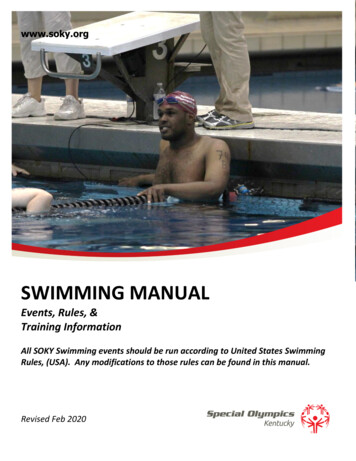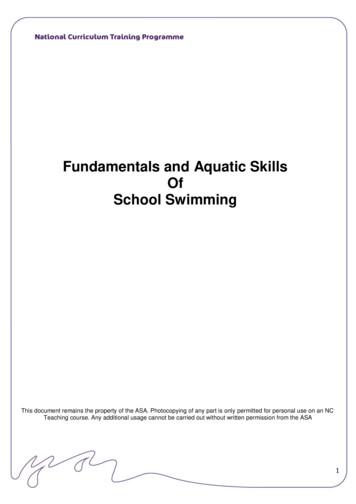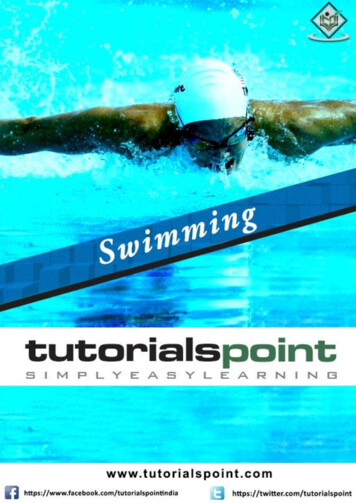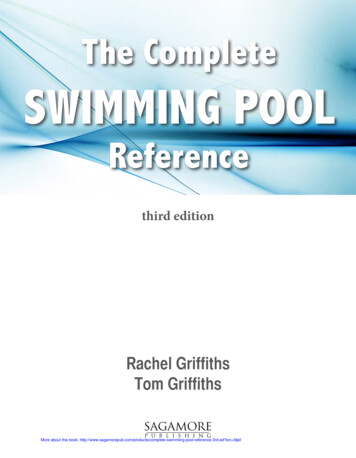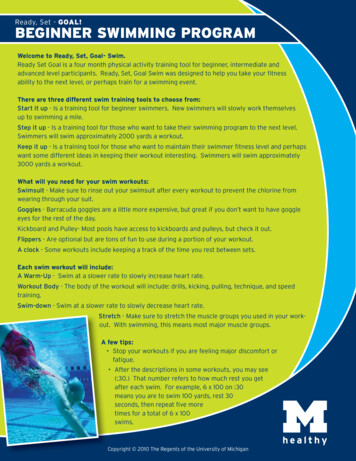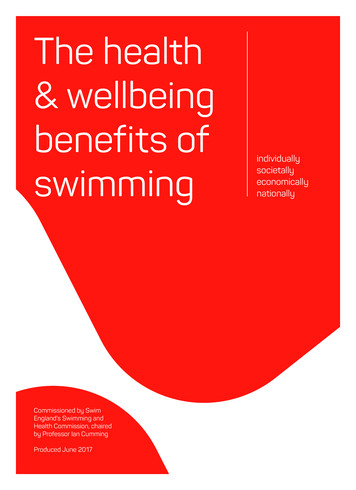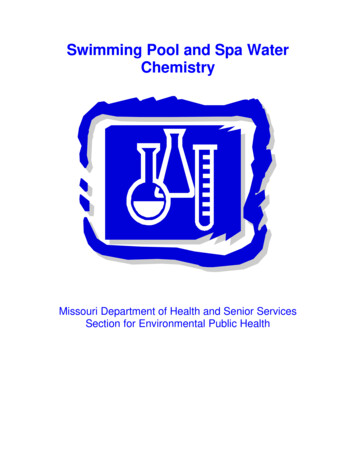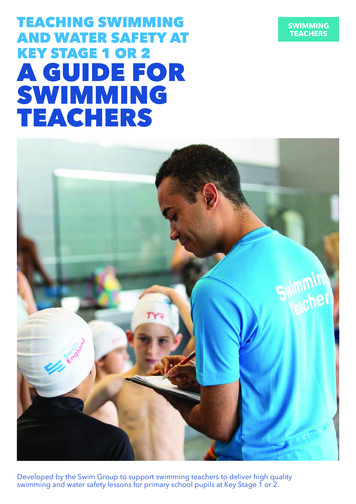
Transcription
TEACHING SWIMMINGAND WATER SAFETY ATKEY STAGE 1 OR 2SWIMMINGTEACHERSA GUIDE FORSWIMMINGTEACHERSDeveloped by the Swim Group to support swimming teachers to deliver high qualityswimming and water safety lessons for primary school pupils at Key Stage 1 or 2.
This guide has been produced by Swim England on behalf of the Swim Group. Thecontent has been developed by experts from a range of organisations involved inthe provision of swimming and water safety lessons in primary schools.This series of guides for primary schools, parents, pool operators and swimmingteachers, is designed to ensure all children meet the requirements of the nationalcurriculum PE programme of study by the time they leave primary school in Year 6.It also aims to ensure the consistent delivery of swimming and water safety lessonsacross the country that fully support the teaching of the three outcomes.For more information and support materials visit www.swimming.org/schools.Teaching Swimming and Water Safety at Key Stage 1 or 2: A guide for swimming teachers2
CONTENTSThe importance of teaching swimming and water safety at primary school.4National curriculum requirements: swimming and water safety.5The three national curriculum requirements.5What do the outcomes mean?.6Beyond the minimum requirements.7Delivering a school swimming and water safety programme.8Roles and responsibilities.9Overview of what to teach.10Assessing progress and attainment.11Assessment scenario.12Teaching qualifications.12Class ratios.12Planning school swimming lessons.13During the lesson.14Additional support.15Key tips for swimming teachers.15More information.16Additional links.16Appendix.17Published by the Swim Group March 2019Design by www.loopdesign.orgTeaching Swimming and Water Safety at Key Stage 1 or 2: A guide for swimming teachers3
THE IMPORTANCE OFTEACHING SWIMMINGAND WATER SAFETY ATPRIMARY SCHOOL123Swimming and WaterSafety is included withinthe national curriculumPE programme of study.Primary school is theonly opportunity someyoung people will haveto learn these importantlife-enhancing andpotentially life-savingskills.Having a goodexperience at school willhelp to build a life-longswimming habit whichcould include numerouswater-based activities.By the time a child is ready to leave primary school they should be able to swim,know how to get out of trouble if they fall into water, know the dangers of waterand understand how to stay safe when playing in and around it.It is part of the national curriculum PE programme of study for England, so alllocal authority-maintained primary schools must provide swimming and watersafety instruction. Other state funded schools, like academies and free schools,must provide a broad and balanced education – and that should include teachingpupils to learn how to swim and about water safety.Swimming teachers are in the perfect position to support schools to fulfill theirstatutory obligation to teach swimming and water safety to all pupils during KeyStage 1 or Key Stage 2.The national curriculum sets out three outcomes which all pupils must be able todemonstrate they can meet before they leave Year 6.This guide is designed to help swimming teachers - whether employed by theschool or through third party providers - to understand what primary schools arerequired to teach and report on. It also sets out some important considerations forhow swimming teachers can support the schools make the most of the lessons.Teaching Swimming and Water Safety at Key Stage 1 or 2: A guide for swimming teachers4
NATIONAL CURRICULUMREQUIREMENTS: SWIMMINGAND WATER SAFETYUnlike other Learn to Swim programmes, the national curriculum swimming andwater safety programme has only three outcomes. These are statutory minimumstandards of capability and confidence in swimming and water safety.It is important that all pupils are supported to meet these requirements beforethey leave primary school. This includes those with special educational needs,those with a disability or impairment and those whose first language is notEnglish.The overall aim of primary school swimming and water safety instruction is tointroduce children to the water - particularly those who may not have alreadybeen in a swimming pool or had lessons. The emphasis is on ensuring all pupilshave the basic skills to be able to enjoy the water safely and know how to safe selfrescue if the worst happens.The programme is not about being able to swim the perfect breaststroke, but toinstill a level of ability and fun that encourages young people to keep developingtheir water skills.The three national curriculum requirementsThe minimum requirement is that, by the time they are ready to leave Key Stage 2,every child is able to: swim competently, confidently and proficiently over a distance of at least 25metres use a range of strokes effectively perform safe self-rescue in different water-based situations1It is expected that many pupils will achieve more than these minimumexpectations. Therefore, school swimming programmes should also provideopportunities for these pupils to further develop their confidence and water programmes-of-studyTeaching Swimming and Water Safety at Key Stage 1 or 2: A guide for swimming teachers5
What do the outcomes mean?1. Swim competently, confidently and proficiently over adistance of at least 25 metresThis means demonstrating: a continuous swim of more than 25 metres without touching the side of thepool or the pool floor without the use of swimming aids. Whenever possible, atleast part of the swim should be completed in deep water, defined as greaterthan shoulder depth. This is because ‘competence’ and ‘proficiency’ can’t beassured if the swim takes place in shallow water only. the stroke, or strokes, are as strong at the end of the swim as at the start, andthat the swim is completed without undue stress. the stroke or strokes are recognisable to an informed onlooker.Using an ineffective stroke and just managing to swim 25 metres does not meetthe minimum requirement. Nor does it provide the skills necessary for pupils to beable to self-rescue if they get into difficulty. A competent, confident and proficientswim over a distance of more than 25 metres is the minimum requirement tomeet the national curriculum outcomes. It is hoped that a number of pupils willbe able to swim significantly further, although evidence of this is not required forprimary schools to officially record (although could be considered for parent andsecondary school reporting).2. Use a range of strokes effectivelyPupils should be able to use a range of strokes and make choices about thestrokes they use to achieve different outcomes and be certain of success.To do this they need to experience simultaneous and alternating strokes, on theirfront and back, and be able to adapt them for a range of purposes and intendedoutcomes. Examples of an intended outcome might be a swim of 50 metres, orusing an effective leg kick to tread water successfully.Swimming strokes do not have to be perfect, the emphasis should be oneffectively achieving the required aim rather than precision hand or feetmovements.Examples of adapting strokes for different outcomes: front crawlUse front crawl withface down and aquaticbreathing to swim in acompetitive raceUse front crawl withhead up to playwater poloUse a front crawl-typeleg kick in a verticalposition to tread waterTeaching Swimming and Water Safety at Key Stage 1 or 2: A guide for swimming teachers6
3. Perform safe self-rescue in different water-basedsituationsPupils should know the dangers of water and understand how to act responsiblywhen playing in or near different water environments. This includes understandingand adhering to national and local water safety advice, being able to useappropriate survival and self-rescue skills if they unintentionally fall in or get intodifficulty in the water, and knowing what to do if others get into trouble.To ensure pupils fully understand this important area, ‘water-based situations’should not only cover how an incident could occur, but also different typesof water space. To support this, schools are encouraged to take advantage ofadditional programmes such as Swim Safe.Examples of how an incident could occur:Falling into water when playing on afootpathFalling out of a boatSwimming in clothesBecoming tiredSustaining an injuryBeing out of one’s depthHampered by weeds or underwaterhazardsRough water or tidesExamples of where an incident could occur:Homes and gardensSwimming poolsBeachesRiversCanalsReservoirsBeyond the minimum requirementsSchool swimming programmes must give regard to three elements of the nationalcurriculum requirements for swimming and water safety but this should not limitthe opportunities made available to all pupils to make progress and achieve.To ensure pupils really are competent, confident and proficient in water, and havethe ability to survive and self-rescue skills, it is best practice to look beyond theminimum requirements.Additionally, within a class or year group, pupils are likely to hold a range ofabilities in these areas. Regardless of prior swimming experience, primary schoolsare encouraged to provide the same lessons to all pupils to provide consistency.This is particularly important with regard to the water safety elements as this is anarea which can never be over-taught.For pupils who reach the minimum swimming and stroke requirements quickly, itis important to provide access to other activities that will help them stay engagedand continue to grow their confidence and capabilities in the water.Teaching Swimming and Water Safety at Key Stage 1 or 2: A guide for swimming teachers7
Examples of additional activities in the pool: Using a range of swimming skills and strokes for different purposes. This couldinclude basic water polo or synchronised swimming elements. Swimming longer distances and for increasing amounts of time. Taking part inevents such as School Swimathon, the School Games swimming galas or the BigSchool Swim can provide different activities. Swimming in different water environments such as a lake or the sea. As wellas activity centre programmes, the free Swim Safe programme provides anopportunity to learn about outdoor swimming and water safety. Approved lifeguard or life-saving training, such as the Rookie Lifeguardprogramme.DELIVERING A SCHOOLSWIMMING AND WATERSAFETY PROGRAMMEDespite being a statutory part of the national curriculum for Key Stage 1 or 2,some primary schools struggle to ensure all their pupils reach the three requiredoutcomes. This can be due to a number of factors including access to facilities,costs associated with delivering the programme or the quality of the programme.Schools are aware that, as a national curriculum requirement, swimming and watersafety provision must be free to all pupils and costs should come out of the school’score budget. This includes costs associated with facilities, swimming teachersand transport. However, primary schools can access the PE and Sport Premium toprovide additionality.The premium can be used to fund the professional development and training thatare available to schools to train staff to support high quality swimming and watersafety lessons for their pupils.The premium may also be used to provide additional top-up swimming lessonsto pupils who have not been able to meet the national curriculum requirementsfor swimming and water safety after the delivery of core swimming and watersafety lessons. At the end of key stage 2 all pupils are expected to be able to swimconfidently and know how to be safe in and around water.Schools are required to publish information on the percentage of their pupilsin year 6 who met each of the 3 swimming and water safety national curriculumrequirements.Primary schools have a number of options when setting up theirswimming programmes: Primary schools deliver all aspects themselves at an on-site or off-site venue. The local school swimming service supports the school by arranging facilityhire, swimming teachers and transport. External providers administer and deliver the programme as a whole package,including in-house swimming teachers.Teaching Swimming and Water Safety at Key Stage 1 or 2: A guide for swimming teachers8
Level 2 Swimming Teachers are frequently more knowledgeable and experiencedabout the teaching of swimming than the school staff that accompany the pupils.Some schools may have up-skilled their teachers via the National CurriculumTraining Programme for swimming, but it is advised that these staff memberssupport the swimming teacher rather than replace.However, school teachers will have greater knowledge about the pupils’ abilityand it is their responsibility to ensure each child reaches the three outcomes.Therefore, in advance of the programme starting, it is useful for the swimmingteacher and the school to discuss the programme and lesson plan to ensure theactivity matches expectations and outcomes.Roles and responsibilitiesThe following highlights the role of the swimming teacher and that of the Primaryschool and teacher/adult.Swimming Teachers The responsibility of the swimming teacher begins when the school teacher,or other school representative, has handed over the group of pupils andinformed them of the number of pupils swimming, together with any additionalinformation about a pupil’s specific needs. The duty of the swimming teacher ends when the pupils leave the water and,whilst still on poolside, are returned to the care of the school teacher or otherschool representative. However school staff must stay on poolside at all times. Swimming teachers must ensure they are aware of the national curriculumrequirements and have attended the relevant training. Swimming teachers should lead on the creation of the programme and lessonplans, in consultation with the school. These should be adapted during theprogramme to reflect the progress made by the individual pupils. Approach each lesson with a degree of flexibility to ensure every pupil isengaged during the lesson and encouraged to make progress. At the end of each lesson, feedback progress to the school teacher so they canupdate the school and parents. At the end of the swimming programme, provide evidence to support theschool to accurately reflect their pupils’ attainment against the three nationalcurriculum requirements.Primary School and Accompanying Teachers/Adults The school is accountable for their pupils’ attainment and progress. Therefore,regular dialogue should take place between school teachers and swimmingteachers to ensure both are aware of the progress made. The school should be aware and agree the overall programme and lesson plansto ensure they fit with the national curriculum requirements. School teachers are required to provide up-to-date, accurate registers of thoseattending the lessons. They should also advise about any individual medicaltreatment needs or special requirements. School teachers are responsible for highlighting any concerns about the paceor content of the lessons, and how the pupils are responding.Teaching Swimming and Water Safety at Key Stage 1 or 2: A guide for swimming teachers9
School teachers/accompanying teaching assistants/support staff areresponsible for general order and discipline. Together, they should maintainhigh levels of supervision in the changing rooms, on poolside and while pupilsare in the water. School staff should play an active role supporting learning and dealing withbehaviour and welfare issues. At the end of each lesson, the school teacher should discuss the progress madeby the class and report back to the school/parents. At the end of the swimming programme, schools must publish details ofhow many pupils within their year 6 cohort have met the national curriculumrequirements. Therefore, good communication between the swimming teacher/provider is important.Overview of what to teachAs with other national curriculum subjects, swimming and water safety lessonsshould have purpose and good pace throughout. Every lesson should beorganised, structured, controlled and continuously monitored from the poolside.Warm up and contrasting activities should also be programmed, structured andcontrolled.To meet the three national curriculum requirements for swimming and the widerphysical activity requirements, school swimming and water safety lessons shouldfocus on developing some or all of the following skills and strokes in differentwater-related contexts: how to enter and exit the waterfloatationsubmergingrotating from back to front and front to back and regaining an upright positionpushing and gliding and an understanding of streamliningaquatic breathingmoving effectively and efficiently through the water using alternating andsimultaneous strokes on front and back, such as front crawl, back crawl, breaststroke, side strokeswimming longer distances and for increasing amounts of timeusing swimming skills and strokes for different purposes such as water polo andsynchronised swimmingsurvival and self-rescue skills: treading water, Heat Escape Lessening Position(HELP) and Huddle positions, floating and resting in the water, attractingattention, sculling and swimming in clothes/buoyancy aidswater safety: knowledge and understanding of different water environments,how to stay safe when playing in and around water including recognising flagsand warning signs and understanding national and local water safety advicewhat to do if others get into difficulties: stay safe, shout, signal, throw, do not gointo the water, raising the alarm 999play competitive games such as water polo and apply basic principles suitablefor attacking and defending.More information about what to teach can be found below and in the followingresources: Primary School - Support Materials, and the Water Safety ResourceTeaching Swimming and Water Safety at Key Stage 1 or 2: A guide for swimming teachers10
Assessing progress and attainmentSchool teachers are accountable for pupils’ attainment, progress and outcomes2.Therefore, the school teacher should be aware of what their pupils are doing atall times, how well they are progressing and what they need to do next in theirlearning.To support teachers to do this, regular and frequent dialogue should take placebetween school teachers and swimming teachers. This helps to ensure bothparties are aware of what the pupils are being taught and what they are learning.This could be recorded by the provider and shared with the school, or the schoolteacher could record the progress directly at the end of each lesson. There area number of electronic systems being used, with new systems continuing to bedeveloped.Schools can choose how they assess water safety and swimming competence andshould discuss their proposed assessment with the swimming teacher to ensureit is viable. The agreed programme should ensure that teachers are able to assesstheir pupil on the following:AttainmentCriteria examplesPerform safe self-rescue skillsFloating, treading water, attractingattention, safe self rescue circuits orscenariosUse different strokes and swimmingskills for different outcomesSwimming lengths, play water polo,tread waterSwim competently, confidently andproficiently further than 25 metresSwim increasingly longer distancesusing a range of strokes, compete in arace or galaTalk about how to behave when in andaround water and how to help in anemergencyBe able to explain where incidentscould take place and what number tocall for helpPupils should demonstrate they meet these elements with certainty, and on morethan one occasion. By repeating the attainment objectives, this will help buildconfidence and ability. When assessing the elements, always consider the extentto which pupils’ skills and strokes would enable them to get themselves out oftrouble if they unintentionally fall in to water or get into difficulty.Simple scenarios can be useful to provide a context for pupils to choose and usestrokes and skills purposefully and for teacher’s to assess competence.2Teachers’ Standards, DfE: 2011Teaching Swimming and Water Safety at Key Stage 1 or 2: A guide for swimming teachers11
Assessment scenarioYou’ve fallen into the water unintentionally. You are wearing a pair of shortsand t-shirt.Without touching the sides of the pool or the pool floor: enter the water and float for 30 secondsrotate and swim on your front for 15 metrestread water for 30 seconds. Try to attract attentionrotate and swim on your back for 15 metresreturn to the side of the pool and exit the water safely.Repeat the assessment in different water based situations.Teaching qualificationsAll those that teach curriculum swimming and water safety, whether employedby the school or through a third party, must have up-to-date knowledge andcompetence to do so safely and effectively. The Health and Safety Executive (HSE)recognises that competence can be demonstrated: with a relevant qualification through in-house training, initial teacher training or in-service training through previous experience.In addition, regular professional learning should take place to ensure knowledgeand working practices are up-to-date.All swimming teachers should hold the following qualifications: Up to date Level 2 Teaching Swimming Qualification. Specific training for teaching primary school swimming and water safety e.g.National Curriculum Teacher of School Swimming - Primary CPD and Teachingschool swimming and water safety (formally know as School swimming and theNational Curriculum) CPD (available via a range of providers including SwimEngland). Relevant training and CPD on supporting swimmers with additional needs. Current DBS check.Class ratiosThe following recommended ratios are starting points for determining actualpupil-teacher ratios, which will depend on the outcome of a risk assessmentdesigned to ensure high quality, effective swimming lessons are delivered.’ Theseratios can be found in ‘Safe Supervision of programmed swimming lessons andtraining sessions (2018)’.Teaching Swimming and Water Safety at Key Stage 1 or 2: A guide for swimming teachers12
Non-swimmers and beginners(Learners with or without floatation aids that cannot swim 10mcomfortably)12:1Improving swimmers(Learners who have mastered stroke technique and have the abilityto swim 10m comfortably and safely.)20:1Mixed ability groups (not including beginners)all should be able to swim 25m minimum.Mixed ability groups are often a necessity in managing schoolgroups.20:1Competent swimmers (those who can swim at least 25 metrescompetently and unaided and can tread water for 2 minutes)20:1Swimmers with special educational needs and disabilities (SEND)Each situation must be considered independently as people withdisabilities are not a homogenous group1-1 upwardsPLANNING SCHOOLSWIMMING LESSONSActivities should be planned in consultation with the school teacher. They shouldtake into consideration the current ability of the pupils, focus on building waterconfidence rather than perfect technique, be challenging, and build on previouslearning. This will help to create a more flexible, inclusive, cross curricularapproach to learning which is more in line with primary school swimming.In addition, consideration should be given to the following general nationalcurriculum requirements:Stamina, stamina, staminaDuring each lesson, nonswimmers, beginners andimprover swimmers all needto swim longer distances andfor longer periods of time tochallenge themselves andimprove. Consider everyoneswimming widths or lengths ofthe pool for the first 10 minutesat various points in the schoolswimming programme. Letchildren use noodles, floats,armbands or other flotation aidsto help them achieve. Every swimming lesson should have purpose andseek to help every child make progress and achieve. Swimming teachers should set high expectationsfor every child. This must include planning activitiesfor pupils who have limited or no previous swimmingexperience and stretching those pupils whoseattainment is significantly above the expectedstandard. Targets should be ambitious for every childin every lesson. Lessons should be planned to ensure that thereare no barriers to every pupil achieving, includingthose with special educational needs, those withan impairment or a disability, and those whose firstlanguage is not English.Teaching Swimming and Water Safety at Key Stage 1 or 2: A guide for swimming teachers13
Swimming groups will usually be larger and of mixed ability. Swimmingteachers, therefore, need to address individual needs, adapting and altering theway in which activities are presented to accommodate and give everyone thebest chance to succeed. This may mean grouping pupils (within the group) andsetting different challenges for each sub-group. Pupils’ spoken language, reading, writing and vocabulary should be an integralpart of every subject, including swimming. By the time they leave year 6 everychild should be able to describe and explain strokes and swimming skills usingcorrect swimming terminology. Swimming lessons can also be opportunities to develop pupils’ confidence touse numbers and mathematical skills through inventive activities. Opportunities should be provided for pupils to engage in pair and group work.This should include observing, discussing and reviewing work with their peers. Pupils should be able to compare their performances with previous ones anddemonstrate improvement to achieve their personal best. Swimming should help pupils to lead healthy, active lives. The serious messagesassociated with learning to swim and water safety need to be presentedthrough fun, engaging activities so that pupils enjoy what they are learning andwill choose to continue swimming into adulthood. Pupils should engage in competitive swimming activities such as Aqua Splashfestivals, intra and inter school galas, water polo competitions or synchronisedswimming festivals.During the lessonBelow are some areas for swimming teachers to thinkabout when planning lesson activity:Snappy one minute starters Write a question about watersafety or swimming on a whiteboard. While the group is waiting tobegin their lesson, ask themto discuss the question andcome up with an answer. Confirm the answer and beginthe lesson. Focus on pupils achieving skills and strokes that willmake them safe in water rather than focusing ontechnique and outcomes. Pupils should be physically active for sustainedperiods of time. All lessons should be well paced andall pupils should be physically active for at least 80per cent of most lessons. This includes lessons thatpredominantly focus on assessing pupils’ progress.Being physically active means increasing heart rates and getting out of breath. Pupils should have a clear understanding of the aims, objectives and learningoutcomes for every lesson. Every child should know how well they are doing and what they need to donext to progress. This means speaking directly to individual pupils and ensuringthey understand what they need to do to improve a stroke or skill. At the endof a lesson ask yourself whether you (or an assistant) have spoken directly toevery child in the group and given them a personal teaching point or target forimprovement. Pupils understand why they are learning specific skills and strokes and how andwhen they can be used. For example pupils should understand that learning howto float is important for survival and self-rescue.A range of information about planning and delivering primary school swimmingand water safety lessons, including sample lesson plans and certificates, can befound on the Swim England website: www.swimming.org/schoolsTeaching Swimming and Water Safety at Key Stage 1 or 2: A guide for swimming teachers14
Additional supportIt should be exceptional for a child not to achievethese minimum requirements. However, wherethis is the case, schools should provide Top-upswimming sessions or signpost pupils to summerschool courses. Parents should also be encouragedto take their child swimming (more information forparents can be found in the Parents Guide).The Chief Medical Officers’guidelines recommend that allchildren engage in at least 60minutes of physical activity aday, of which 30 minutes shouldbe in school.Together with schools, swimming teachers must do all th
Swimming in different water environments such as a lake or the sea. As well as activity centre programmes, the free Swim Safe programme provides an opportunity to learn about outdoor swimming and water safety. Approved lifeguard or life-saving training, such as File Size: 1MBPage Count: 21

